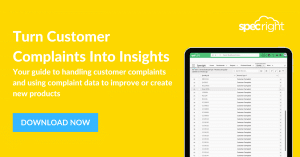Businesses spend lots of money to understand their customers. From focus groups to feedback surveys and reviews, product development teams usually focus on what customers want. But when it comes to complaints, customers typically find themselves in a blackhole of customer service representatives.
A study by Harvard Business Review found that customers who have a complaint handled in less than 5 minutes spend more on future purchases. And customers who have an issue but don’t complain often just stop doing business with you. What businesses don’t realize is that complaints can be more valuable than praise when it comes to product refinements and innovation.
Customer complaint data can be the inspiration for your next product development cycle. With effective data management, you can turn customer complaints into your next great product.

1. Intelligently Capture Complaint Data
Between retention and new product ideation, customer complaints are valuable input for supply chain teams. But most of the time those who would benefit the most from this feedback don’t have visibility into it. That’s because this feedback lives in chat bots, hotlines, or review sites – and isn’t tied back to the product. To make customer complaints actionable, they need to be tied to the product. Specification Management software can bridge the data sharing gap between customer service, product teams, and suppliers. Add linkages from crucial complaint data directly to product specifications to help codify complaints for more effective resolution.
Best Practices for Capturing Complaint Data
In order to create this feedback loop, we’re seeing customers log complaints in Specright and tie them to the finished good plus any associated specifications (like lot codes, supplier information, or manufacturing processes).
By tying complaints to specification data, users can get to the bottom of issues faster, figure out which product features work and which don’t, as well as develop new products. There’s a lot of data you can capture surrounding complaints, so we created a customer complaint workflow and included a glimpse of how you can do this in Specright.
2. Making Complaints Work for You in the Product Development Cycle
Now that you have complaint data on file and attached to all necessary information, you can use it to either correct and improve a product or create a new one.
For example, one of our customers used feedback to adjust a formula after customers complained about the flavor of a new product. Because they tied customer complaints to finished goods, they were able to quickly identify this trend in customer feedback. As a result, they immediately altered the formula, tracked it as a formula revision, and automatically updated the finished good and production lot specs. Complaints about the flavor immediately decreased. With the ability to track all of this data, the voice of the consumer is put front and center in the product development cycle, enabling higher ROI and increased customer loyalty.
3. Using Data to Support Continuous Improvement
So you’ve refined or created new products and have a bunch of happy customers; the benefits don’t stop there. Share these wins across your organization. With all complaints and corrective actions documented, change the stigma surrounding customer complaints. Demonstrate what’s possible with the right data in the right hands.
To learn more about how you can start making your customer complaints work for you, reach out to a member of our team or book a demo.
Explore More Blogs
Get Started
With Specright’s Solution Suite, you can digitize, centralize, and link your specification data to drive efficiencies, intelligence, traceability, and collaboration within your organization and across your supply chain network.




